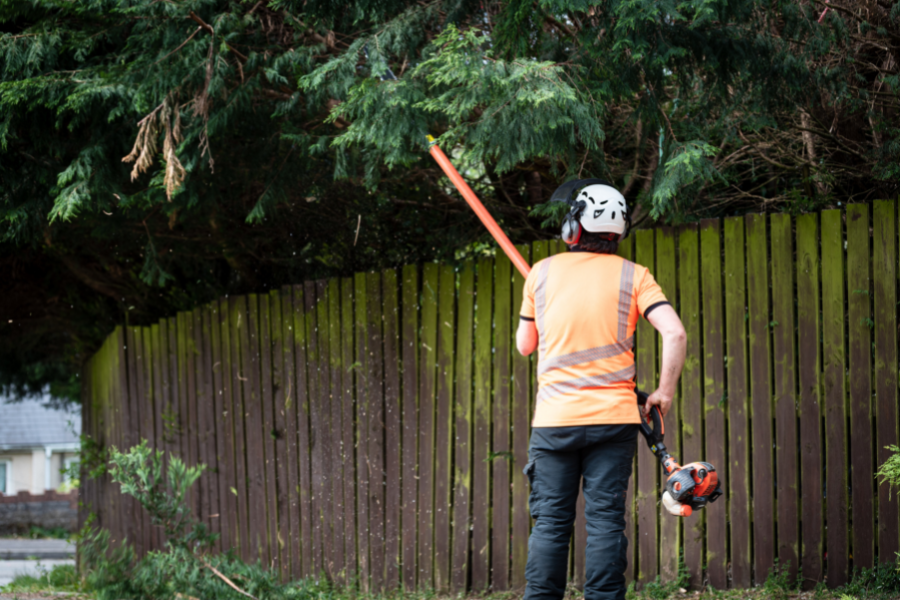Spring is a time of renewal, and that includes giving your trees some much-needed TLC after a long winter. Healthy trees not only enhance your landscape’s beauty but also provide valuable shade, improve air quality, and even boost your property value.
This blog will guide you through a spring tree maintenance checklist, focusing on proper pruning techniques.
H2: How do you take care of a tree that grows?
Spring is a great time to focus on tree care. Here’s a detailed checklist:
Step 1: Inspection is Key
Before diving into more hands-on tasks, take a good look at your trees. This initial inspection sets the stage for the rest of your maintenance routine.
Overall Health Check: Look for signs of winter damage like broken branches, cracks in the trunk, or discolouration of leaves. Are there any visible signs of pests or disease? Early detection is crucial for addressing potential problems.
Inspect Trunks and Branches: Examine the trunk for any wounds, oozing sap, or fungal growth. Check branches for signs of weakness, disease, or insect infestation.
Check for Pests: Look for signs of insect damage like chewed leaves, webbing, or unusual growths.
Step 2: Cleaning Up for Spring
With a thorough inspection complete, it’s time to clear away debris and create a healthy environment around your trees.
Time for a Spring Clean: Remove any fallen leaves, branches, or debris that have accumulated around the base of the tree. This debris can harbour pests and diseases, and removing it improves air circulation.
Clearing: Clear away any weeds or unwanted vegetation competing with your trees for nutrients and water.
Step 3: Nourishing the Soil
Once the area around your tree is clean, it’s time to focus on providing the nutrients it needs to thrive.
Fertilization: Replenishing the soil with essential nutrients is vital after winter’s depletion. Choose a slow-release fertilizer specifically formulated for trees, following the application instructions carefully.
Work on Soil Improvement: If you suspect your soil is lacking in specific nutrients, a soil test can help determine the best course of action. Amending the soil with organic matter like compost can also enhance its quality and water retention.
Step 4: Smart Watering Practices
As spring progresses and temperatures rise, watering becomes increasingly important. Water deeply and infrequently, allowing the water to penetrate the root zone. Avoid shallow watering, which encourages roots to grow closer to the surface and become more susceptible to drying out.
Step 5: Mulching and Root Protection
Mulching: Apply a fresh layer of mulch (2-4 inches thick) around the base of the tree, keeping it a few inches away from the trunk. Mulch helps retain moisture, regulate soil temperature, and suppress weed growth.
Tree Root Protection: If your tree is located near construction work or areas with heavy foot traffic, consider installing protective barriers around the root zone to prevent damage.
Step 6: Pruning with Purpose
Prune Your Trees: Proper pruning removes dead, diseased, or damaged branches, improves air circulation, and encourages healthy growth. However, pruning should be done strategically.
Target Pruning: Focus on removing problematic branches and avoid excessive pruning. Consult a certified arborist for expert advice for large trees or those requiring significant work.
We highly recommend our readers hire a professional for tree pruning.
Step 7: Maintaining Tree Health Throughout the Season
Disease: Stay vigilant for signs of disease like discolouration of leaves, wilting, or unusual growths. Early detection and treatment can help prevent the spread of disease.
Flush Away Salts: In areas with high mineral content in the water, occasional deep watering can help flush away salt buildup that can harm tree roots.
Planting New Trees:
Spring is also a great time to plant new trees! Carefully choose the right tree species for your climate and growing conditions. Ensure proper planting techniques are followed to give your new tree the best chance of success.
Wrapping Up
By following these steps, you can ensure your trees are healthy, vibrant, and ready to flourish throughout the spring and summer seasons. Remember, a little springtime TLC goes a long way in nurturing these valuable natural assets in your landscape.




 A tree surgeon will begin by analysing the tree’s overall health. They will use specialised equipment to measure the tree’s health indicators, such as bark thickness and the presence of rot. They will develop a strategy based on the findings.
A tree surgeon will begin by analysing the tree’s overall health. They will use specialised equipment to measure the tree’s health indicators, such as bark thickness and the presence of rot. They will develop a strategy based on the findings.







